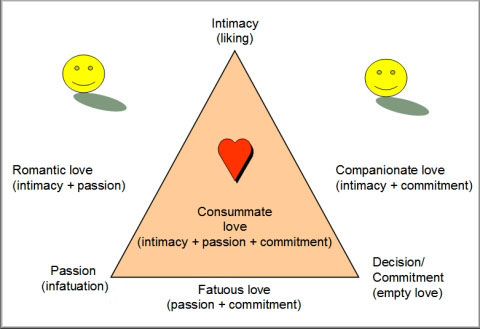|
|

|
Ψ Attraction & Intimacy: Liking & Loving Others
|

|
|
What leads to friendship and attraction?
• Reward Theory of Attraction: Attraction toward others is a function of the reinforcements we experience when we are with the person.
Ψ Four Main Areas of Attraction:
• Proximity
• Physical attractiveness
• Similarity versus
Complementarily
• Liking
Those Who Like Us
Ψ Proximity
• Proximity is better thought of as functional distance (how often people's paths cross). Functional distance strongly predicts liking.
• Anticipation of interaction: Just expecting to interact with someone leads us to like them more. In essence, we are setting the environment for behavioral confirmation. If we expect to like someone, the interaction should go more smoothly.
• Mere Exposure: The more we see something the more we like it (as long as exposure isn’t incessant). The mere-exposure effect is adaptive, a "hardwired" phenomenon that predisposes our attractions & attachments & helps us keep away from danger. Downside: wariness of the unfamiliar.
Ψ Physical attractiveness
• Appearance does matter! The consistency & pervasiveness of "good looks" is disconcerting.
• Research indicates that the more attractive a female is, the more likely she is to date. The effect is slightly less strong for males.
• The Matching Phenomenon: Couples (even friends) tend to be relatively equal in attractiveness. When the partners are not relatively equal in attractiveness, the less attractive partner usually compensates on some other factor (e.g., very wealthy older men marrying beautiful young women).
• The Physical Attractiveness Stereotype: “That which is beautiful, is good.” People within a culture, assume that attractive people have the traits that are valued by that culture. Adults & children are biased toward attractive people.
• Who is attractive? To be really attractive is to be perfectly average. Symmetrical & “average” faces are seen as most attractive. To become more attractive average features are exaggerated (e.g., fuller lips and larger eyes in a women).
• Evolution and Attraction: What is beautiful in women generally indicates fertility. In men, attractive traits tend to indicate the ability to provide & protect.
• The contrast effect: What's attractive to you depends on your comparison standards. Men find most women to be less attractive after watching really attractive women on TV. Men find their spouses less attractive after viewing centerfolds or pornographic films. This is true for your self-perceptions also, people find themselves less attractive after viewing other “more attractive” people.
• The Attractiveness of Those We Love: Although we like attractive people more, we also tend to find people we like to be attractive! The more in love we are with someone, the more attractive we view them, & the less attractive we view others of opposite sex.
Ψ Similarity versus Complementarity
• Birds of a feather do flock together. Likeness begets liking. The greater number of shared attitudes, the more likable you find the person, particularly if you like yourself! Of course, the opposite is also true, we tend to dislike those who hold different opinions than us.
|

|
• Complementarity: The popularly supposed tendency, in a relationship between two people, for each to complete what is missing in the other.
Ψ Liking Those Who Like Us
• Does liking a person cause that person to like us? Yes.
• Rebound Effect: Attacks on a person’s self-esteem (from someone else) can lead them to like a person more as a result. Women who received critical personality assessments rated an attractive male confederate as being more likeable than those who received a positive evaluation.
Ψ Our Need To Belong
• Our need to belong is illustrated by the effects of ostracism. Ostracism generally refers to informal modes of exclusion from a group through shunning. Shunning is the act of deliberately avoiding association with, & habitually keeping away from an individual. To thwart our need to belong is to unsettle our life.
What is love?

• Psychologist Robert Sternberg views love as a triangle, whose three sides consist of passion, intimacy, & commitment.
Ψ Passionate Love is emotional, exciting, & intense. Elaine Hatfield (1988) defined it as “a state of intense longing for union with another”. Passionate love is mostly expressed in a physical manner while maintaining an exclusive relationship.
Ψ Schacter & Singer’s Two Factor theory, is a theory of emotion suggesting that human emotion has two components (factors): physiological arousal & cognition (a conscious understanding of that arousal). According to the theory, "cognitions are used to interpret the meaning of physiological reactions to outside events." It appears that physical arousal from any source intensifies feelings of passion.
• Time & culture both have an affect on the love formed in a relationship, e. g. In non-Western cultures, love often follows marriage.
• Gender: Men tend to fall more readily in love & seen to fall out of love more slowly, Men are less likely to break up a premarital romance. Women may be more emotionally involved & are more focused on the intimacy of the relationship & on concern for their partner.
Ψ Companionate Love is best defined as a passionate love that has settled to a warm enduring love between the two partners in a relationship.

• Psychologist Robert Sternberg conception of the kinds of loving as combinations of the 3 basic components of love.
• In his 1973 book The Colors of Love, John Lee compared styles of love to the color wheel. Just as there are three primary colors, Lee suggested three primary & three secondary styles.
Primary: • Eros – self-disclosing passion
• Ludos – Love as a game
• Storge – Love as friendship
Secondary • Mania (Eros + Ludos) – Obsessive love
• Pragma (Ludos + Storge) – Realistic & practical love
• Agape (Eros + Storge) – Selfless love
Ψ Maintaining Close Relationships
• Equity theory: the idea that people are happiest with relationships in which the rewards & costs experienced & the contributions made by both parties are roughly equal.
• Long-term equity is achieved by not focusing on “who owes who” in a relationship. When one partner provides the other with their needs, a form of return in not expected. Being able to look past & not feel that a debt is owed, is what allows the relationship to last.
Ψ Self-Disclosure
• Deep, Companionate relationships allow us to feel accepted for who we are. An important part in the growth of a
relationship is the self-disclosure process. Exposing ones innermost thoughts & weaknesses helps to nurture love. The nature of the disclosures steadily progresses in a increasing fashion, due to disclosure reciprocity (disclosure begets disclosure).
• Carl Rogers (1980) identified 3 factors which make growth promoting listeners effective (at eliciting disclosure): people who are
• genuine in revealing their own feelings.
• accepting of other people’s feelings.
• empathetic & sensitive listeners.
Ψ Internet Effects
• The internet provides a pathway for computer-mediated communication within virtual communities, it is not the real thing, & does not work as well as the real thing.
• The "digital divide" accentuates social & educational inequalities. "Balkanization" (diversity of viewpoints both good & bad) is built into the system. From the work of Robert Putnam: Bowling Alone: The Collapse and Revival of American Community (2000, ISBN 0-7432-0304-6).
|

|
Ψ Ending Relationships
• Often, when people perceive a relationship to be unequal, they will end the
relationship. The closer & longer the relationship has lasted, the more painful the breakup.
• Who Divorces: Individualistic Cultures (where love is a feeling not an obligation) have more divorce than do communal cultures.
• People usually stay married if they:
• Have a stable income
• Were married after age 20
• Are religiously committed
• Are well and similarly educated
• Date a long while before marriage
• Are of similar age, faith, and education
• Both grew up in stable, two-parent homes
• Did not cohabitate or become pregnant before marriage
• The Detachment Process: Severing bonds produces a predictable sequence of agitated preoccupation with the lost partner, followed by deep sadness &, eventually, the beginnings of emotional detachment & a return to normal living. From the work of Hazan & Shaver (1994).
Social Psychology
Robert C. Gates
|

|
|
 “The greatest degree of inner tranquility comes from the development of love and compassion. The more we care for the happiness of others, the greater is our own sense of well-being.” “The greatest degree of inner tranquility comes from the development of love and compassion. The more we care for the happiness of others, the greater is our own sense of well-being.”
- Tenzin Gyatso, 14th Dalai Lamat
|
|




















